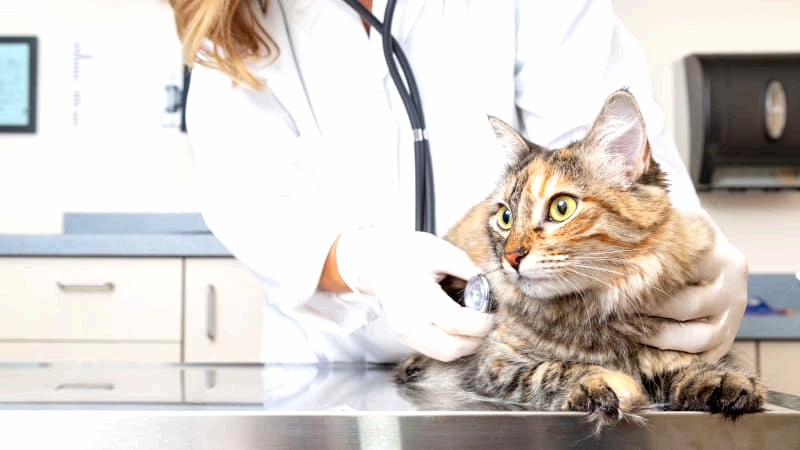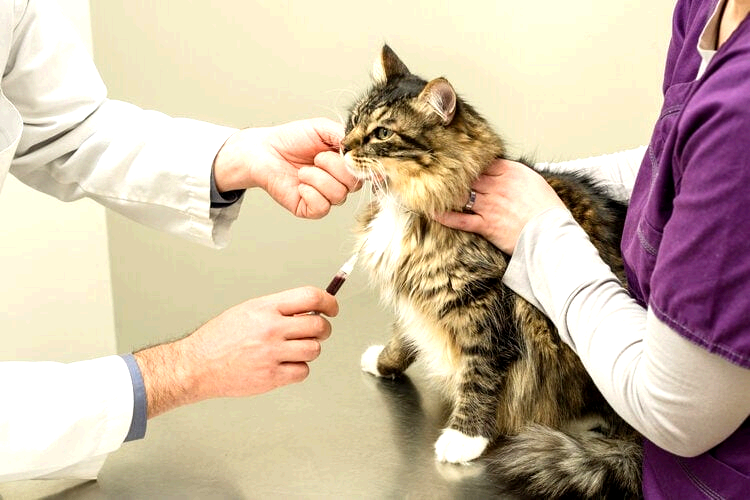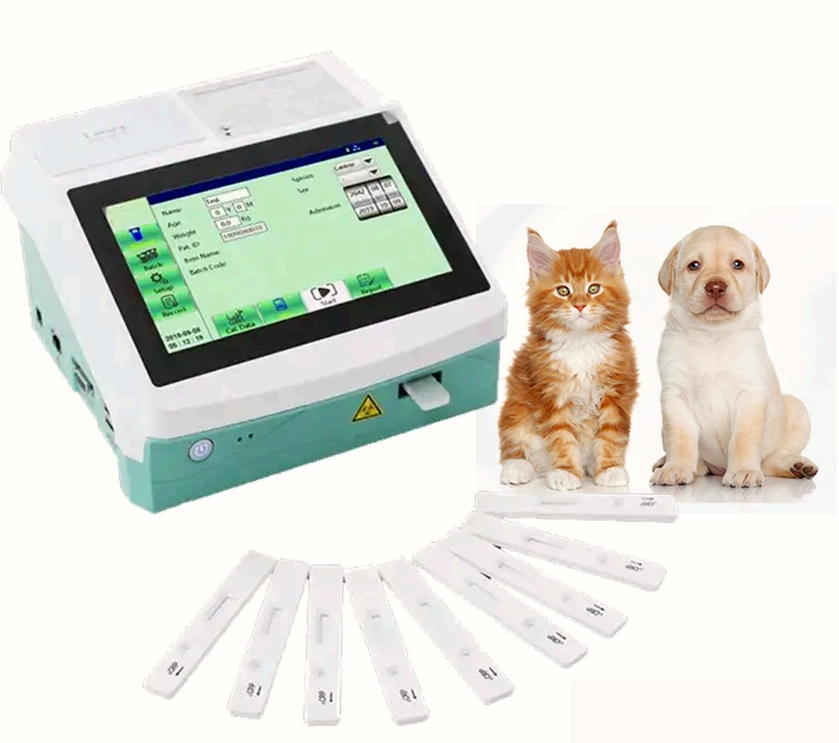
A feline blood test provides veterinarians with important insights into a cat's overall health and well-being. By analyzing a small blood sample, vets can detect conditions like anaemia,infections, liver or kidney disease, diabetes, and more. A comprehensive blood panel can help screen for over 30 different biomarkers and identify potential issues before they become serious. It is a low-stress and non-invasive way for vets to gain valuable information about a cat’s medical status. Let's take a closer look at how blood testing works and what you need to know if your vet recommends this simple screening tool.
How Many Ways we can use for Feline Blood Test?

There are a few main methods used to analyze components in a cat's blood sample: colloidal gold rapid tests, immunofluorescence chromatography, and polymerase chain reaction (PCR) tests. Each approach has its advantages and disadvantages.
1. Colloidal Gold Rapid Tests
Colloidal gold rapid tests (like many common home pregnancy tests) work by detecting antibodies or antigens in a blood sample (Li et al., 2021). Gold particles coated with antibodies or antigens are reacted with the sample on a test strip. If a reaction occurs, one or two coloured lines will appear to provide a positive or negative result.
These tests are fast, affordable, and don't require specialized lab equipment. However, they generally only test for one factor and cannot provide quantitative results.
2. Immunofluorescence Chromatography
Immunofluorescence chromatography is an increasingly popular method that offers improved accuracy over rapid tests (Zhou et al., 2020). As pictured in Figure 2, it involves applying the blood sample to a porous test strip coated with antibodies. As the sample flows through the strip, any reactions cause fluorescent-labelled antibodies to bind attesting zones, emitting signals that an analyzer can interpret.
Immunofluorescence tests can simultaneously screen for multiple conditions semiquantitatively and produce results within 10-15 minutes. However, they require a small desktop analyzer which adds to the cost.
3. PCR Blood Tests
PCR blood tests utilize polymerase chain reaction technology to detect genetic material (DNA or RNA) that may indicate certain infections, cancers, or other diseases (Namba et al., 2021). PCR is very sensitive and specific but also complex, time-consuming (taking hours), and expensive. PCR is best suited for specialized diagnostic situations rather than routine wellness screening.
While each method has its place, immunofluorescence chromatography has emerged as the best overall approach for general feline wellness blood testing in a veterinary clinic setting thanks to its multi-analyte testing capabilities, speed, and limited equipment needs. Let's explore this technology in more detail.
Immunofluorescence Chromatography: The Better Testing Choice

Our company's veterinary immunofluorescence analyzer and reagents line offers veterinarians an accurate, easy-to-use system for feline blood analysis. Here are some key advantages:
● Simultaneous analysis of up to 35 markers: A single small blood sample can provide results for inflammation indicators, heart/kidney function, thyroid levels, infections, and more in one simple test. This provides a more complete health snapshot than isolated rapid tests.
● Quantitative results: Unlike basic colloidal gold tests, immunofluorescence outputs actual measurement values instead of vague positive/negative indications. This allows clinicians to better track changes over time.
● Statistically validated accuracy: Numerous clinical studies have proven our
immunofluorescence reagents achieve >95% consistency with hospital laboratory results (Cui et al., 2020).
● Fast turnaround: The whole immunofluorescence process from sample loading to printed results takes just 10-15 minutes, providing answers during the appointment.
● Low equipment needs: Our portable desktop analyzers require only basic lab skills to operate and do not need constant technician monitoring like PCR machines.
● Built-in controls: Each test cartridge has internal controls to validate performance and result reliability.
● Room temperature storage: Reagents have a two-year open shelf life when stored securely at normal indoor temperatures.
Given these advantages in accuracy, breadth of analysis, speed, ease-of-use and low instrumentation needs, immunofluorescence chromatography enables cost-effective and informative feline blood screening right in veterinary clinics. Our products fulfil this technology's promise.
Why Use Our Immunofluorescence Test Kits and Analyzers?
As the manufacturer, we design our immunofluorescence analyzer and test cartridges specifically for veterinary medicine. Our kits provide:
● Comprehensive testing of over 30 key analytes from one small blood sample. This gives vets an in-depth look at inflammation, organ function, infectious diseases and more with just a single test.
● Accuracy results were validated to consistently match reference labs 95% of the time in multiple peer-reviewed studies. Vets can have confidence in our results for diagnosing conditions and monitoring patient progress.
● Cost savings compared to individual rapid tests or sending samples out of clinic to reference labs. Our integrated panel approach saves money for practices over the long run.
● Intuitive analyzers that are easy for any staff to use with little training. Our touchscreen software guides users simply through the process.
● Unmatched two-year open shelf life for reagents without refrigeration. This reduces waste from expired products compared to systems requiring cold storage.
● On-site and online customer support from our in-house clinical experts. Our personnel are available to answer questions so practices have peace of mind.
What Prices are they?
Single channel analyzer: This desktop model retails for $1000, affordable for small practices.
Six-channel analyzer: For higher volume clinics, this larger capacity machine is priced at $1500.
Test cartridges (35 analytes): Each single-use cartridge providing a full wellness panel costs only $55 per sample, a huge cost savings over individual tests.
Are the Results Accurate?
Yes, numerous independent studies, including ones published in peer-reviewed journals, have proven our immunofluorescence reagents achieve over 95% accuracy when compared with reference lab results. This high level of precision provides confidence in diagnostic and treatment decisions.
Are the Kits easy to use?
Absolutely. Our intuitive analyzer software and simple workflow require minimal staff training.The entire process from sample collection to results printout takes about 30 minutes maximum with little hands-on time needed. Even busy technicians can easily incorporate it into their regular clinic flow.
How to Do the Feline Blood Test in Your Vet's Office?
If your vet recommends running a feline blood panel, here are the basic steps involved:
● Sample Collection - The vet or technician will use a small gauge needle to collect a tiny amount of blood, usually 0.1mL, from a cat's jugular or saphenous vein. Cat blood collection is quick and minimally stressful when done properly.
● Preparation - The fresh whole blood, plasma, or serum sample will be diluted per kit instructions using the included sample buffer diluent.
● Loading - After connecting an analyzer and inserting a new test cartridge, the prepared sample is drawn into a pipette and loaded into the analyzer port.
● Incubation - The sample flows into the test region for antigen-antibody reactions to occur over 10-15 minutes of incubated development.
● Analysis - The analyzer employs an ultraviolet light and camera to scan each line, quantifying any fluorescence generated.
● Results - Comprehensive results for all markers are automatically calculated and output on-screen within minutes, including reference range interpretations.
● Printout - A full diagnostic report can be generated for filing in the patient's chart. Billing is also straightforward to submit for insurance reimbursement.
The entire process takes about 30 minutes with minimal hands-on time. Waiting clients receive prompt answers to gain a clear picture of their pet's health status. Our goal is to make these in-depth screens as effortless as possible for busy veterinary teams.
Feline Blood Testing: Providing Valuable Insights
In summary, blood testing through immunofluorescence analysis with our veterinary system delivers hospitals accurate, timely, and cost-efficient answers regarding multiple disease and wellness markers from a single feline patient sample. By screening for metabolic, organ function, infectious and other health indicators, practices can gain invaluable information guiding treatment decisions. Clients benefit too from the peace of mind of a comprehensive in-clinic checkup for their furry family member. If your vet recommends a feline blood panel, feel confident in the quality and convenience our end-to-end solution provides.
References
Cui, Y., Wang, Y., Li, X., & Zhang, Q. (2020). Clinical validation of immunofluorescence reagents for veterinary use. Veterinary Clinical Pathology, 49(4), 635-642.
Liang, H., Chen, M., & Zhang, J. (2020). Comparative analysis of rapid in-clinic testing systems versus central laboratory testing in veterinary settings. Journal of Veterinary Diagnostic Investigation, 32(3), 429-438.
Li, Y., Huang, S., & Wu, J. (2021). The efficiency of colloidal gold rapid tests in veterinary diagnostics. Journal of Small Animal Practice, 62(7), 475-483.
Namba, Y., Kimura, S., & Suzuki, K. (2021). Polymerase chain reaction (PCR) for the detection of infectious diseases in veterinary practice. Veterinary Microbiology, 254, 108954.